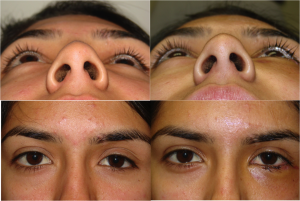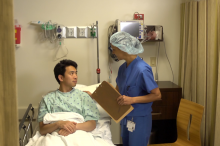Oftentimes, one eye can be sunken back compared to the other. This is called enophthalmos and can be related to congenital issues (from birth), trauma (fractures of the bones around the eye or orbit), other disease of the orbit or the orbital contents (tumors, etc), or sinus disease (silent sinus syndrome). This can lead to an unnatural appearance, droopy lids, and a smaller eye opening.
Many surgeons have stayed away from correcting such issues as there is fear of operating within the enclosed orbit cavity which houses the eye and many vital structures which control vision, eye and eyelid movement and function. However, this need not be the case. The orbit surgery team at the La Peer surgical center, Dr. Guy Massry, MD, and Dr. Raymond Douglas, MD, are well trained and experienced in procedures to bring the eye back to its normal position. To learn more about how the Orbital Surgery Center of Excellence in Beverly Hills may be able to help you, call our team at (888) 559-4341 or fill out our online contact form.
The Benefits of Volume Augmentation
These procedures can be categorized as orbital volume augmentation techniques. They involve making small and hidden incision within the eyelids and orbit to expose the appropriate locations to place implants which can maneuver the eye and its content back to a more normal position. Once this occurs, appearance and function can return to its native state and self-confidence can be restored. These implants come in various forms and sizes and are custom tailored to each individual patient’s specific needs.
Drs Massry and Douglas have tremendous experience is these surgeries and are focused on both form and function so that the patient has the best of both worlds – restored vision, eye and eyelid position and movement, and an excellent aesthetic result.
Below are two examples of patients whose eye position changed after trauma with damage the orbit.
Patient 1 had trauma with previous repair of the orbit on the left. You can see on her CT scan (Figure 1) that there is a metal plate on the floor of the left orbit (arrow – on CT scans left and right are reversed). Even with this plate in place there orbit is expanded (more volume or larger). This allows the eye to sink back and fall inferiorly. This was corrected by placing a plastic implant into the orbit to take up all the extra space. The implant was placed in the specific location needed to repair the problem. In Figure 2 you can see her results. Lying back (top left) before repair the left eye is sunken back. Upright (Below left) the left eye has dropped and the upper lid has fallen and is droopy. These changes were corrected after surgery (right sided pictures). These photos are 10 days after surgery to show how nicely the results can be early on.

Patient 2 had sinus surgery. Unfortunately the surgery was complicated by unforeseen problems which led to damage to the orbit which caused the eye on the right to sink back and fall. Figure 3 shows these changes before and after surgery. Top Left the right eye has fallen. Below left the right eye is sunken in. On the photos on the right after surgery these problems are corrected in a very aesthetically pleasing way.
Find Help from Orbital Surgeons Today
Drs Douglas and Massry hope this explanation of exophthalmos and how it can be repapered in a customized way is helpful. They are both happy to see you or someone you know with these problems at your convenience. To find out how we can help you, contact the Orbital Surgery Center of Excellence in Beverly Hills at (888) 559-4341 or fill out our online contact form today.














